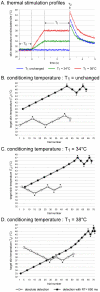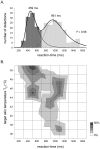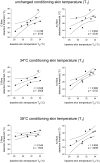Thermal detection thresholds of Aδ- and C-fibre afferents activated by brief CO2 laser pulses applied onto the human hairy skin
- PMID: 22558230
- PMCID: PMC3338467
- DOI: 10.1371/journal.pone.0035817
Thermal detection thresholds of Aδ- and C-fibre afferents activated by brief CO2 laser pulses applied onto the human hairy skin
Abstract
Brief high-power laser pulses applied onto the hairy skin of the distal end of a limb generate a double sensation related to the activation of Aδ- and C-fibres, referred to as first and second pain. However, neurophysiological and behavioural responses related to the activation of C-fibres can be studied reliably only if the concomitant activation of Aδ-fibres is avoided. Here, using a novel CO(2) laser stimulator able to deliver constant-temperature heat pulses through a feedback regulation of laser power by an online measurement of skin temperature at target site, combined with an adaptive staircase algorithm using reaction-time to distinguish between responses triggered by Aδ- and C-fibre input, we show that it is possible to estimate robustly and independently the thermal detection thresholds of Aδ-fibres (46.9±1.7°C) and C-fibres (39.8±1.7°C). Furthermore, we show that both thresholds are dependent on the skin temperature preceding and/or surrounding the test stimulus, indicating that the Aδ- and C-fibre afferents triggering the behavioural responses to brief laser pulses behave, at least partially, as detectors of a change in skin temperature rather than as pure level detectors. Most importantly, our results show that the difference in threshold between Aδ- and C-fibre afferents activated by brief laser pulses can be exploited to activate C-fibres selectively and reliably, provided that the rise in skin temperature generated by the laser stimulator is well-controlled. Our approach could constitute a tool to explore, in humans, the physiological and pathophysiological mechanisms involved in processing C- and Aδ-fibre input, respectively.
Conflict of interest statement
Figures





References
-
- Bromm B, Jahnke MT, Treede RD. Responses of human cutaneous afferents to CO2 laser stimuli causing pain. Exp Brain Res. 1984;55:158–166. - PubMed
-
- Carmon A, Mor J, Goldberg J. Evoked cerebral responses to noxious thermal stimuli in humans. Exp Brain Res. 1976;25:103–107. - PubMed
-
- Plaghki L, Mouraux A. EEG and laser stimulation as tools for pain research. Curr Opin Investig Drugs. 2005;6:58–64. - PubMed
-
- Treede RD. Neurophysiological studies of pain pathways in peripheral and central nervous system disorders. J Neurol. 2003;250:1152–1161. - PubMed
-
- Plaghki L, Mouraux A. How do we selectively activate skin nociceptors with a high power infrared laser? Physiology and biophysics of laser stimulation. Neurophysiol Clin. 2003;33:269–277. - PubMed
Publication types
MeSH terms
LinkOut - more resources
Full Text Sources

